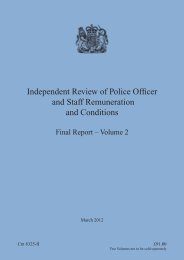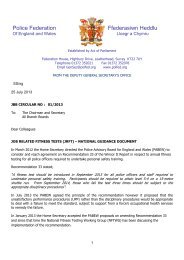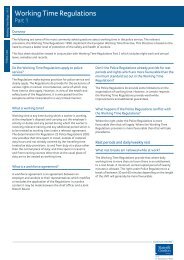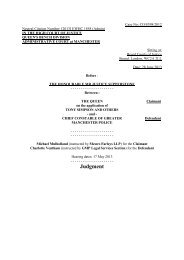Final Report - Volume 1 - the South Wales Police Federation
Final Report - Volume 1 - the South Wales Police Federation
Final Report - Volume 1 - the South Wales Police Federation
You also want an ePaper? Increase the reach of your titles
YUMPU automatically turns print PDFs into web optimized ePapers that Google loves.
SummaryHealth, fitness and managing <strong>the</strong> officer workforce19 The public expects <strong>the</strong> police service to respond and advance when, and where, o<strong>the</strong>rswould retreat. <strong>Police</strong> officers and staff can face dangerous situations and often do so withlittle thought for <strong>the</strong>ir own safety. A level of physical strength and fitness is required as aprerequisite to joining as a police constable, measured by a nationally-determined fitness test.However, <strong>the</strong> public may be surprised to learn that once an officer has passed his probation, hemay never be subject to any test of his physical fitness again.20 Chief constables have a duty of care to ensure that <strong>the</strong>ir officers and staff deployed on <strong>the</strong>frontline are sufficiently fit to deal with <strong>the</strong> likely risks to <strong>the</strong> safety of <strong>the</strong> public, and to<strong>the</strong>mselves. Value for money considerations are also apposite. Professor Disney has found thatpolice officers’ pay scales are 10-15% higher than many comparable public sector workers,and this is partly because officers can be deployed to use <strong>the</strong>ir warranted powers at any time,anywhere. If officers can no longer justify that additional pay, <strong>the</strong>n <strong>the</strong>y should not receive it. Ihave recommended that a new annual fitness test should be undertaken by all officers who maybe deployed on <strong>the</strong> frontline. Where an officer repeatedly fails this test, he should be requiredto relinquish <strong>the</strong> appropriate proportion of his pay. For a constable at <strong>the</strong> top of his pay scale,this would be £2,922 of pensionable pay.21 The numbers of officers already in this category of restricted duties has grown significantlyin recent years – from 2,299 officers in 2002/03 to 6,137 officers in 2010/11. In some forces,this is as high as 9.4% of <strong>the</strong>ir total officer workforce. If an officer on restricted duties cannotreturn to full deployment in <strong>the</strong> longer-term, <strong>the</strong>re should be powers to remove him, offer him asuitable police staff role if his skills are critical, or use <strong>the</strong> ill-health retirement mechanism. Thelatter should be used more often than at present, especially in <strong>the</strong> cases of officers seriouslyinjured or incapacitated in <strong>the</strong> course of duty.22 In considering <strong>the</strong> future challenges that <strong>the</strong> police service may face, it is also important toequip Chief Constables with <strong>the</strong> instruments <strong>the</strong>y need to respond to economic trends. It cannotbe assumed that funding for <strong>the</strong> police service will return to pre-2009 levels; indeed <strong>the</strong>remay be need for fur<strong>the</strong>r reductions in funding. Until now, police staff members have taken<strong>the</strong> brunt of <strong>the</strong>se cuts in force budgets through compulsory redundancy. This is unfair. AsPolicy Exchange have noted, such reductions in police staff have reversed recent achievementsin <strong>the</strong> civilianisation of roles. In many cases, this has been <strong>the</strong> only option available to ChiefConstables, but it represents poor value for money for <strong>the</strong> taxpayer, who faces paying highersalaries to police officers to do jobs which could – and should – be done at lower cost by moreable and experienced police staff.23 I have carefully considered <strong>the</strong> arguments for maintaining a protection from compulsoryseverance for police officers, including whe<strong>the</strong>r a system of short service commissions akinto those used in <strong>the</strong> military would be preferable. There is nothing intrinsic in <strong>the</strong> office ofconstable which would be incompatible with police officers being considered for compulsoryseverance alongside police staff who are facing redundancy. Regulation A19 – which allowsa police force to require <strong>the</strong> retirement of an officer with 30 years’ service on <strong>the</strong> groundsof <strong>the</strong> efficiency of <strong>the</strong> force – and <strong>the</strong> powers of police authorities and police and crimecommissioners to require a Chief Constable to resign or retire, conspicuously establish thatfact. Accordingly, I recommend that all police officers under chief officer rank with lessthan full pensionable service should be subject to a latent power of compulsory severance.Financial compensation should be on <strong>the</strong> same basis as is available to employees who are maderedundant.21












